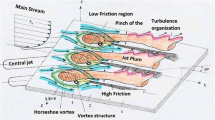Abstract
In this paper, the performance of the turbine blade squealer tip with film cooling has been studied detailed to highlight the impact of the relative motion between the blade tip and the shroud. A high-pressure turbine has been employed to perform the numerical simulation. Boundary conditions are consistent with the operating conditions of the plane cascade experiment in a transonic wind tunnel. The validation of the turbulent model and mesh independence test has been conducted based on the experimental results. The distribution of blade tip heat transfer coefficient (HTC) and film cooling effectiveness has been used to evaluate the blade tip performance. Two different relative speeds and three different film holes arrangements have been adopted and studied to understand its influence. Results show that with relative motion and film cooling, the blade tip overall aerothermal characteristics remains unchanged. But the local HTC on several regions has significantly changed due to the complex interaction among the leakage flow, coolant, and relative motion. And the relative motion has a significant impact on the coolant, which redirects the coolant towards the pressure side of the blade and changes the coolant coverage inside the cavity.













Similar content being viewed by others
Data availability
The data that support the findings of this study are available from the corresponding author upon reasonable request.
References
Acharya S, Moreaux L (2014) Numerical study of the flow past a turbine blade tip: effect of relative motion between blade and shroud. J Turbomach 136(3):471–480
Azad GS, Han JC, Boyle RJ (2000) Heat transfer and flow on the squealer tip of a gas turbine blade. J Turbomach 122(4):725–732
Han JC, Dutta S, Ekkad S (2001) Gas turbine heat transfer and cooling technology, 2nd edn. CRC, Boca Raton
He K (2017) Investigations of film cooling and heat transfer on a turbine blade squealer tip. Appl Therm Eng 110:630–647
Kwak JS, Han JC (2003) Heat transfer coefficients and film cooling effectiveness on the squealer tip of a gas turbine blade. J Turbomach 125(4):494
Ma H, Zhang Q, He L et al (2017) Cooling injection effect on a transonic squealer tip—Part I: experimental heat transfer results and CFD validation. J Eng Gas Turbines Power 139(5):052506
Ma H, Zhang Q, He L et al (2017) Cooling injection effect on a transonic squealer tip—Part II: analysis of aerothermal interaction physics. J Eng Gas Turbines Power 139(5):052507
Oldfield MLG (2008) Impulse response processing of transient heat transfer gauge signals. J Turbomach 130(2):739–750
Park JS, Lee DH, Rhee DH et al (2014) Heat transfer and film cooling effectiveness on the squealer tip of a turbine blade. Energy 72:331–343
Rezasoltani M, Lu K, Schobeiri MT et al (2014) A combined experimental and numerical study of the turbine blade tip film cooling effectiveness under rotation conditions. J Turbomach 137(5):051009
Rhee DH, Cho HH (2006) Local heat/mass transfer characteristics on a rotating blade with flat tip in low-speed annular cascade—Part I: near tip surface. J Turbomach 128:96–109
Rhee DH, Cho HH (2006) Local heat/mass transfer characteristics on a rotating blade with flat tip in low-speed annular cascade—Part II: tip and shroud. J Turbomach 128:110–119
Sakaoglu S, Kahveci HS (2020) Effect of turbine blade tip cooling configuration on tip leakage flow and heat transfer. J Turbomach 142(2):021008
Srinivasan V, Goldstein RJ (2003) Effect of endwall motion on blade tip heat transfer. J Turbomach 125:267–273
Tong F, Gou W, Li L et al (2015) Investigation on heat transfer of a rotor blade tip with various film cooling holes arrangements and groove depths. Adv Mech Eng 7(2):427–431
Wang J, Sundén B, Zeng M et al (2012) Influence of different rim widths and blowing ratios on film cooling characteristics for a blade tip. J Heat Transfer 134(6):061701
Zhang B, Qiang X, Kong Q, Lu S (2018) The influence of film cooling holes arrangement on turbine blade squealer tip heat transfer characteristic. In: Proceedings of 2018 heat engine aerothermodynamics and fluid machinery annual conference by society of engineering thermophysics
Zhang DH, Zeng M, Wang QW (2009) The influence of rotating speed on film cooling characteristics on GE-E3 blade tip with different tip configurations. Turbo Expo: Power Land Sea Air 48845:1017–1025
Zhou C, Hudson H, Lock G (2015) Thermal performance of different cooled tips in a high-pressure turbine cascade. J Propulsion & Power 28(5):900–911
Zhu D, Zhang Q, Lu S et al (2020) Relative casing motion effect on squealer tip cooling performance at tight tip clearance. J Therm Sci Eng Appl 2020:1–18
Acknowledgements
This work is partially supported by the Aeronautical Science Foundation of China (2015ZB57003).
Author information
Authors and Affiliations
Contributions
XQ contributed to the conception of the study and performed the experiment. BZ performed the experiment and contributed to the initialization of numerical simulation. HL conducted the numerical study, performed the data analyses, and wrote the manuscript.
Corresponding author
Ethics declarations
Conflict of interest
The authors declare that they have no conflict of interest.
Ethical standard statement
This article does not contain any studies with human or animal subjects performed by any of the authors.
Rights and permissions
About this article
Cite this article
Luo, H., Qiang, X. & Zhang, B. Research on turbine blade squealer tip film holes arrangement and moving shroud. AS 5, 491–501 (2022). https://doi.org/10.1007/s42401-022-00139-9
Received:
Revised:
Accepted:
Published:
Issue Date:
DOI: https://doi.org/10.1007/s42401-022-00139-9



